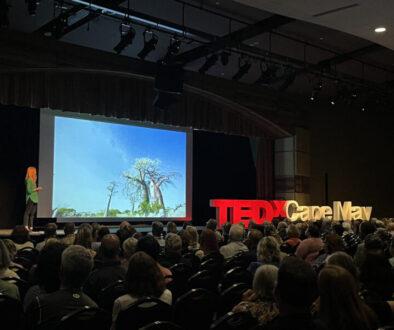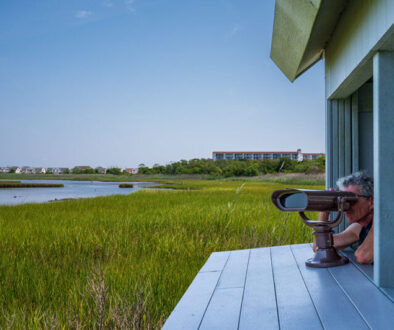The Light Beneath the Sea
A profile of artist Adam Wallacavage


Hidden behind a vine-covered facade in South Philadelphia, in a house that once held medical secrets within its pink-painted walls and forgotten hallways, Adam Wallacavage has spent the past quarter century sculpting a world of subaquatic wonder and its many glowing arms.
Equal parts Victorian fantasy, punk ethos, and oceanic dreamscape, his three-story rowhome is an evolving sculpture, a lifelong sketchbook that is the beating heart of his artistic practice and a beloved home he shares with his wife, artist Jodi Rice.
“I often describe it as if the Munsters lived next to the Addams Family in Pee-Wee’s Playhouse near the ocean,” Wallacavage says with a grin.
The sentiment lands. A quick dive online reveals a house that is wacky, gothic, luminous, and strange. It is a deeply personal altar of makeshift materials and spiritual salvage, rooted in one artist’s playfully sacred attention to detail. It shines with so much obvious love, as does Adam himself. Much like his famous tentacled creations. Searching for the things that swim in darkness, to bring them light.
I met Adam for a chat by our very own slice of waterfront, at Cape May’s prestigious Jawbone Gallery, with artist/owner Victor Grasso, a man equally acquainted with the things that slither through watery nether regions. Hours passed unnoticed as we reveled in tales, laughter, and good company. And as we sat beneath the gleam of Adam’s tentacled chandeliers, he and his creations seemed all the more radiant in their proximity.
Wallacavage was drawn early to the ocean, to dark rides and seashell shops, to skateboard culture, and the peculiar magic of 1970s beach towns. Even then, he painted, drew, and crafted. “It was always there,” he says of his artistic impulse. “I can’t remember a time before it.”
But art is often born of fracture and formation. “I was maybe four. I was in the attic, or somewhere,” he recalls. “And I found the painting that I had made for Santa Claus. He didn’t take it.” He paused with a wry smirk. “I guess my parents had hidden it so I wouldn’t know that Santa Claus didn’t take it. I thought it was pretty good. I mean, I know he probably has a lot of stuff, but…”


The moment lingers in the space between the comedic and the wounded. It reveals just a flicker of quiet disillusionment. One of those early collisions between imagination and the indifference of the world. And perhaps, in that gentle disenchantment, something essential was planted.
After high school, underwhelmed by the conventions of traditional higher education, Adam chose to enlist in the Seabees, the Navy’s construction battalions. It was a choice influenced in part by exposure to his own father’s service.
“My dad was a reservist for a long time, so I used to go with him on weekends to Willow Grove.” Adam’s frequent trips with his father to Naval Air Station Joint Reserve Base Willow Grove, located in Montgomery County, Pennsylvania, came amidst the death throes of Cold War panic.
“It’s kind of weird, but growing up in the eighties, HBO had this show about Nostradamus, and it scared the crap out of me,” Adam told us. “I always thought we were going to have World War III, and that I should join the military, so I don’t get drafted.”
But the wonder that binds us in childhood can often overcome, or even work within the confines of, our learned anxieties. And the sea beckoned him still. “I made the recruiters put me in San Diego for boot camp, and Port Hueneme for my training school, because I wanted to be in California.”
Port Hueneme is a small beach city in Ventura County, California, home of Naval Base Ventura County, and the Port of Hueneme, the only deep-water harbor between Los Angeles and the San Francisco Bay area. It is one of only a few west coast military ports.
“During training school at Port Hueneme, I would go down to LA all the time. That was the first time I got to see the La Luz de Jesus Gallery on Melrose Avenue back in the day, and different galleries in Hollywood.”
Following his return home, Adam picked up shifts at a one-hour photo lab, and took community college photography classes, until receiving a scholarship to University of the Arts.
“I went there for photography, even though I was already shooting for skateboard magazines. I just used it for the facilities, and for making giant prints and whatnot. I was doing silk-screening, sculpture, mold making, and offset printing. I got a lot out of that school.”
Adam’s return to the east coast laid in another important coordinate on his journey to artistic self-realization.
“I was involved in a lot of different art scenes in New York in the mid-nineties. I wanted to be in the galleries, but the stuff I was making… I was trying to make what I thought other people would want, but I didn’t even like it.”
It’s an all-too-common trope for a young artist finding his path. Sometimes realizing what you don’t want out of life and a career can lead you to your destination, like seeing an image born out of negative space.
He remembers, “There was this one guy who said to me ‘Why are you looking to do Art Nouveau? Why are you trying to remake a style that’s been done? It’s the new millennium. You should be using these styles to make your own thing’, and I was like, ‘That’s a really good point.’”


Adam spent a lot of time at the Metropolitan Museum of Art in New York, in the period rooms, studying the timelessness and imperfections in certain pieces, gaining confidence and searching for his own unique voice, the promise of a life spent shaping his own creations still a glimmer on the horizon.
“But what I did do is I would shoot. I was documenting.”
Adam’s list of early photographical accolades is extensive and impressive. He got his professional break as a staff photographer for Thrasher Magazine around this time. He shot many different artists for publications such as Juxtapoz and Swindle, was featured in books around the scene such as The Beautiful Losers and spent a decade or so as a commercial photographer.
“I never quit, I just said I have to move on from this. And that’s when I started selling chandeliers,” he says proudly. “I’ve been making a living off of just the chandeliers now for a long time.”
Wallacavage’s tentacled chandeliers are unlike anything else. A surrealist craft born of whimsy and function. They began as an experiment. A way to transform his house into the opulent dream space he couldn’t afford to buy but could teach himself to build.
“I found my place when I got my house and started to make something specifically for myself. That’s what clicked.”
In the early 2000s, after gutting and repainting much of the house, Adam became obsessed with restoring the sense of ornament that had been stripped away during its midcentury conversion. Inspired by Art Forms in Nature, Ernst Haeckel’s otherworldly encyclopedia of biological geometry, he set out to reimagine Victorian plasterwork through his own unique lens.
“If I want something I can’t afford or that doesn’t exist, I make it,” he says. “That’s what I want people to take away. Make your own stuff. Make weird things. Make it yours.”
He began sculpting octopus arms by hand, making molds, and casting them in plaster. The process wasn’t easy. “I wasn’t a sculptor,” he admits. “And it’s hard to curve something like that. They’re heavy, they twist, and you don’t want them to kink.” The earliest chandeliers were improvised from whatever was on hand, until a friend introduced him to Magic Sculpt, a two-part epoxy putty, which allowed finer detail, easier shaping, and more surreal organic forms.
The work was slow, often difficult, and intensely physical. “People don’t see all the little parts. The molds, the wire supports, the layering, the weight distribution,” he says. “It’s a whole process. It’s a lot of muscle memory.”
At first, he was making them just for his own rooms. “The Jules Verne Room,” as he calls it, was the testing ground, his first real dive into underwater fantasy ornament. But when he finally showed the chandeliers publicly in 2006 at Jonathan LeVine Gallery in the Chelsea neighborhood of Manhattan, the response was immediate. They didn’t look like anything else in the design world. Part Lovecraft. Part baroque. Part sunken alien altar. And they’ve never stopped evolving.
“I feel like I’m constantly innovating now. I just keep learning new techniques.”
He’s used everything from antique glass beads and Christmas ornaments to resin-cast bat wings and recycled brass. Some are suspended in theatrical clusters. Others are minimalist, symmetrical, pulsing with sea-foam hues or bioluminescent finishes. Some are cute. Some are grotesque. Most are both. His art is meant to be accessible, enjoyed.
“I want kids to be able to love the work without explanation.” Adam states. That immediacy matters. He’s not aiming for academic galleries. He’s after delight, mystery, and a sense of wonder. Something engaging, inclusive, and rooted in the odd beauty of our shared existence.


Wallacavage’s world is a vibrant current of artists, punks, skaters, and collectors. His early skateboarding ties helped shape the house. Friends helped rebuild the greenhouse, move salvage, and install molding. He’s collaborated with painters, marine biologists, musicians, shipwreck divers, and gallerists.
“I’ve always loved Adam’s work,” shares Victor Grasso. “And when I finally got to meet him, it felt like I had known him forever.”
This sense of community has bolstered Adam’s profile. His work is enjoyed by people of all ages and walks of life. He’s created custom pieces for clients ranging from museums to Miley Cyrus. But the attitude behind them has never shifted.
“They’re not precious,” he says. “I mean, they look fragile, but they’re not. They’re meant to be touched, moved, remade. I’ve broken them, glued them back together, changed them. They’re alive.”
Wallacavage’s art, at once fantastical and emotionally raw, occupies a strange space. Outsider art with technical mastery. “It’s DIY, yeah,” he says. “But I want the end result to feel valuable. That tension is the point.”
In a world of mass-produced lighting and formulaic interiors, Adam’s chandeliers remain defiantly personal. Each one is a luminous artifact of a lifelong conversation between the strange, the sacred, and the sea.
“The ocean is endless. It’s got a connection to everything in the world. Anything could pop up. Dead or alive.” Wallacavage says. He’s been diving, spear fishing, and swimming since childhood. He describes his artistic connection to water as mythic.


“There’s definitely a spiritual connection. I think I’ve always felt that since I was little.” That childlike awe has carved indelible grooves upon Adam’s psyche.
“I have recurring dreams of standing at the top of the bridge coming into Cape May, near the Lobster House,” he said. “For some reason, the top of that, I don’t think I’ve ever stood there. But I always dreamt I was up there looking out over the harbor.”
At Cape May’s Jawbone Gallery, Adam Wallacavage’s chandeliers gleam like artifacts from another world. Suspended above the floor like deep-sea apparitions, they pulse with whimsy, memory, and myth. Their tentacles twist outward in invitation and defiance. Their surfaces shimmer like something dredged from the ocean floor or perhaps dreamed into being by it. And yet the true magic lies not in the chandeliers themselves, but in the man who makes them.
We can see him clearly in our imagination, tucked away in the third-floor studio of his eclectic home, working late into the night. The air smells faintly of resin and metal and paint. He hums. He mutters. He pumps the music of Brian Jonestown Massacre a little louder. He reaches for a tool. The octopus arm he’s forming curls toward the ceiling light like it’s already remembering how to glow.
This has always been the spirit of the house. It is a co-conspirator. A sacred bond built over time, mistake by mistake, dream by dream, a haunting in the best way. “If there are spirits here, they like me,” he laughs. “This house has always been peaceful.”
Asked if there is anything he would change about his home, given the chance to start over with a blank canvas, “I’d probably move to Cape May,” he says with a chuckle.
As the sun sets over the island and the water begins to shimmer in dream light, it’s easy to imagine Adam’s chandeliers floating through underwater depths, glowing in the dark, beckoning strange sea creatures home.



